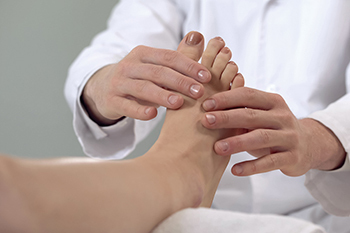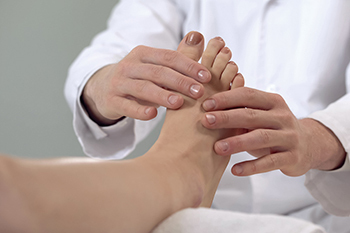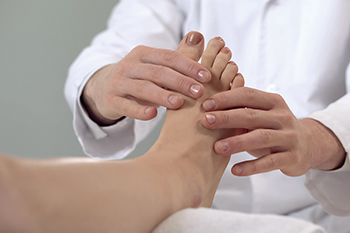Items filtered by date: September 2022
Why Ankle Pain Occurs

Having ankle pain is a good indicator that an injury has happened to the ankle bone or the surrounding joints. The ankle is in the perfect position where the foot bones and leg connect. There are three joints in the ankle, and each has a function. These functions include providing stability to hold the body’s weight, moving the body forward while walking or running, and providing shock absorption for daily movements. Common symptoms that can accompany ankle pain is the inability to walk, swelling, and the ankle can have a throbbing or tingling sensation. The pain from an Achilles tendon injury may travel to the ankle and can make it difficult to complete daily activities. Additional reasons why ankle pain occurs include having arthritis, bursitis, edema, or an ankle fracture. Many times, there is a distinctive reason why ankle pain exists, so it is strongly suggested that a podiatrist be consulted who can perform a proper diagnosis and treat your ankle pain.
Ankle pain can have many different causes and the pain may potentially be serious. If you have ankle pain, consult with Dr. Kevin Davis from Davis Foot & Ankle Centers. Our doctor will assess your condition and provide you with quality foot and ankle treatment.
Ankle pain is any condition that causes pain in the ankle. Due to the fact that the ankle consists of tendons, muscles, bones, and ligaments, ankle pain can come from a number of different conditions.
Causes
The most common causes of ankle pain include:
- Types of arthritis (rheumatoid, osteoarthritis, and gout)
- Ankle sprains
- Broken ankles
- Achilles tendinitis
- Achilles tendon rupture
- Stress fractures
- Tarsal tunnel syndrome
- Plantar fasciitis
Symptoms
Symptoms of ankle injury vary based upon the condition. Pain may include general pain and discomfort, swelling, aching, redness, bruising, burning or stabbing sensations, and/or loss of sensation.
Diagnosis
Due to the wide variety of potential causes of ankle pain, podiatrists will utilize a number of different methods to properly diagnose ankle pain. This can include asking for personal and family medical histories and of any recent injuries. Further diagnosis may include sensation tests, a physical examination, and potentially x-rays or other imaging tests.
Treatment
Just as the range of causes varies widely, so do treatments. Some more common treatments are rest, ice packs, keeping pressure off the foot, orthotics and braces, medication for inflammation and pain, and surgery.
If you have any questions, please feel free to contact our office located in Springfield, TN . We offer the newest diagnostic and treatment technologies for all your foot care needs.
What Is Morton’s Neuroma?

Morton’s neuroma is a nerve condition that causes severe pain in the ball of the foot. It usually involves damage to the nerves that run between the third and fourth toes. Some link the feeling to that of having a small pebble in their shoe. The tissue around the nerve becomes thickened which can cause burning pain in the ball of the foot that radiates to the toes. Morton’s neuroma may also cause numbness and tingling. Many believe that wearing high-heeled shoes is a factor in the development of Morton’s neuroma. Some relief may be found by switching to footwear with a lower heel and a wider toe box. Other treatment options include rest, pain medication, orthotics, and injections. In severe cases, surgery may be necessary. If the pain in the ball of the foot persists or gets worse, it is wise to visit a podiatrist for an exam as well as more advanced treatment options.
Morton’s neuroma is a very uncomfortable condition to live with. If you think you have Morton’s neuroma, contact Dr. Kevin Davis of Davis Foot & Ankle Centers. Our doctor will attend to all of your foot care needs and answer any of your related questions.
Morton’s Neuroma
Morton's neuroma is a painful foot condition that commonly affects the areas between the second and third or third and fourth toe, although other areas of the foot are also susceptible. Morton’s neuroma is caused by an inflamed nerve in the foot that is being squeezed and aggravated by surrounding bones.
What Increases the Chances of Having Morton’s Neuroma?
- Ill-fitting high heels or shoes that add pressure to the toe or foot
- Jogging, running or any sport that involves constant impact to the foot
- Flat feet, bunions, and any other foot deformities
Morton’s neuroma is a very treatable condition. Orthotics and shoe inserts can often be used to alleviate the pain on the forefront of the feet. In more severe cases, corticosteroids can also be prescribed. In order to figure out the best treatment for your neuroma, it’s recommended to seek the care of a podiatrist who can diagnose your condition and provide different treatment options.
If you have any questions, please feel free to contact our office located in Springfield, TN . We offer the newest diagnostic and treatment technologies for all your foot care needs.
Are Bunions Affecting Your Everyday Life?
Who Is Prone to Cuboid Syndrome?

Cuboid syndrome is a foot condition that can occur when the cuboid bone moves out of alignment. This can happen as a result of an acute injury or can gradually become misplaced as the aging process occurs. It can be more common among athletes and dancers than in the rest of the population and is generally triggered by physical activity. Pain and discomfort with cuboid syndrome are felt on the outside of the foot and the pain may be relieved when the weight is taken off the foot. Additional symptoms of this condition can include a limited range of motion in the foot and ankle and there may be bruising and swelling on the sole of the foot. People who have an abnormal foot structure like flat feet may be prone to developing cuboid syndrome. Additionally, patients who are obese, people who run on uneven surfaces, and wearing shoes that do not fit correctly may be possible causes of cuboid syndrome. Mild relief can come frequently resting the foot, and temporarily stopping the activity that may have caused this condition. This is a foot condition that is treated by a podiatrist, and it is suggested that you contact one for permanent treatment options if you are afflicted with cuboid syndrome.
Cuboid syndrome, also known as cuboid subluxation, occurs when the joints and ligaments near the cuboid bone in the foot become torn. If you have cuboid syndrome, consult with Dr. Kevin Davis from Davis Foot & Ankle Centers. Our doctor will assess your condition and provide you with quality foot and ankle treatment.
Cuboid syndrome is a common cause of lateral foot pain, which is pain on the outside of the foot. The condition may happen suddenly due to an ankle sprain, or it may develop slowly overtime from repetitive tension through the bone and surrounding structures.
Causes
The most common causes of cuboid syndrome include:
- Injury – The most common cause of this ailment is an ankle sprain.
- Repetitive Strain – Tension placed through the peroneus longus muscle from repetitive activities such as jumping and running may cause excessive traction on the bone causing it to sublux.
- Altered Foot Biomechanics – Most people suffering from cuboid subluxation have flat feet.
Symptoms
A common symptom of cuboid syndrome is pain along the outside of the foot which can be felt in the ankle and toes. This pain may create walking difficulties and may cause those with the condition to walk with a limp.
Diagnosis
Diagnosis of cuboid syndrome is often difficult, and it is often misdiagnosed. X-rays, MRIs and CT scans often fail to properly show the cuboid subluxation. Although there isn’t a specific test used to diagnose cuboid syndrome, your podiatrist will usually check if pain is felt while pressing firmly on the cuboid bone of your foot.
Treatment
Just as the range of causes varies widely, so do treatments. Some more common treatments are ice therapy, rest, exercise, taping, and orthotics.
If you have any questions, please feel free to contact our office located in Springfield, TN . We offer the newest diagnostic and treatment technologies for all your foot care needs.
Children's Feet are Different Than Adult's Feet

There are 26 bones in each foot, and they are designed in a complex way to support the body, absorb shock while walking and running, and conform to specific surfaces. When babies are born, their feet are mostly cartilage, which will harden into bones at approximately 13 years of age. The bones will develop gradually, and it is beneficial for them to wear shoes that fit properly when walking begins. Research has indicated the feet grow the fastest in the first three years, and may grow up to nine sizes during that time. Greater activity levels in children produce more stress in the feet than adults, and it is suggested that shoes which have extra cushioning be worn during the early years. Children’s shoes may show wear and tear faster than adult’s shoes, and this may be the result of excess sweating that occurs during physical activities. There are many choices to consider when purchasing children’s shoes, and it is advised that you speak with a podiatrist who can help you to make the right decision for your children’s feet.
The health of a child’s feet is vital to their overall well-being. If you have any questions regarding foot health, contact Dr. Kevin Davis of Davis Foot & Ankle Centers. Our doctor can provide the care you need to keep you pain-free and on your feet.
Tips for Keeping Children's Feet Healthy
- Make sure their shoes fit properly
- Look for any signs of in-toeing or out-toeing
- Check to see if they have Clubfoot (condition that affects your child’s foot and ankle, twisting the heel and toes inward) which is one of the most common nonmajor birth defects.
- Lightly cover your baby’s feet (Tight covers may keep your baby from moving their feet freely, and could prevent normal development)
- Allow your toddler to go shoeless (Shoes can be restricting for a young child’s foot)
- Cut toenails straight across to avoid ingrown toenails
- Keep your child’s foot clean and dry
- Cover cuts and scrapes. Wash any scratches with soap and water and cover them with a bandage until they’ve healed.
If you have any questions, please feel free to contact our office located in Springfield, TN . We offer the newest diagnostic and treatment technologies for all your foot care needs.

